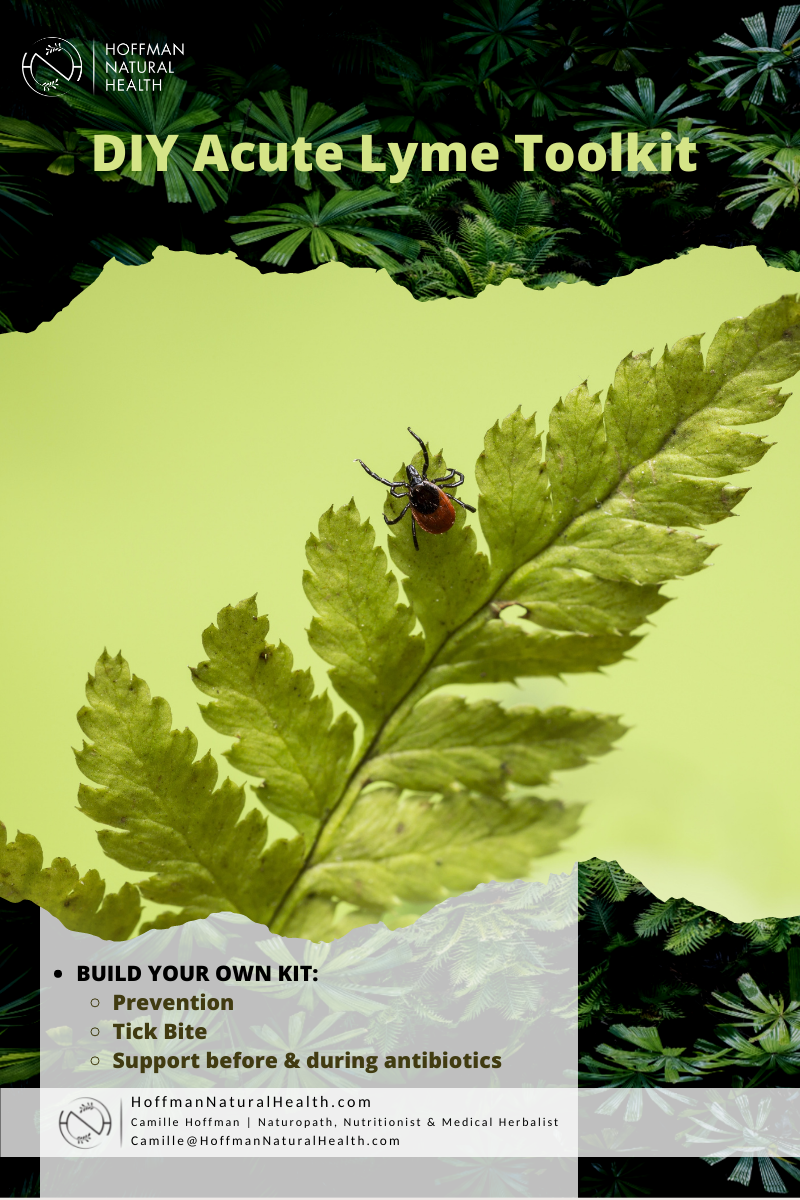It’s Lyme Time
Spring in New England is synonymous with two things: mud and ticks. Okay, it’s not ALL bad…Spring time also brings the sound of peepers and sugaring season. But really…the tick problem kind of overshadows all of that, and certainly ups the stress game for anyone going outdoors. The tick season seems to be lengthening with less severe winters, and its habitat increasing…which is incredibly worrying as contracting Lyme can go on to cause debilitating chronic symptoms. Since I’ll be visiting soon, I’ve created a “Lyme Kit”, everything I need to deal with a tick bite properly and provide immediately immune and anti-bacterial support…and I want to share it with you!
WHAT IS LYME?
First, the basics: Lyme disease, also known as Lyme Borreliosis or simply Borreliosis, is a bacterial infection transmitted by ticks carrying the bacterium Borrelia burgdorferi. Blacklegged ticks, aka deer ticks, range from the size of a poppy seed to sesame seed, and can spread this bacteria and other pathogens, including Bartonella, Anaplasma, Ehrlichia, and Babesia, known as Lyme co-infections.
SYMPTOMS OF STAGE 1 LYME DISEASE:
Also known as early dissemination, stage 1 Lyme symptoms are generally experienced anywhere from days to 1 month after the tick bite.
Symptoms of chronic Lyme can vary from person to person, and sometimes take years to develop, which is why it is extremely important to prevent chronic Lyme by addressing the acute infection as soon as possible.
Here are the typical symptoms of early stage Lyme:
Erythema migrans rash – bullseye rash or other forms (see image) experienced in roughly 50% of infections
Headache
Joint pain
Fever
Fatigue
However, symptoms vary, some do not have any symptoms, experience only a few, or have all of the above…and sometimes more. If the infection spreads, chronic Lyme disease can develop, which can eventually cause more symptoms, including extreme fatigue, headaches, muscle pain, arthritis, numbness, tingling, nerve pain and weakness, heart problems, psychiatric symptoms (anxiety, depression, irritability, psychosis, etc.), sleep issues, cognitive issues, and and problems with vision and hearing.
TREATMENT APPROACH
This is one of those times when most natural practitioners agree with mainstream medicine in the use of antibiotics. This is because the devastating effects of chronic Lyme far outweigh the damage done by antibiotics.
HOWEVER, the naturopathic approach does diverge from the CDC guidelines that declare that in order to transmit the bacteria, the tick must be attached for 24 hours. Presumably for this reason, the CDC doesn’t recommend antibiotic treatment without symptoms unless the tick was attached for 36 hours or more.
What’s wrong with this? Well, first of all, not everyone that is infected with Lyme will develop symptoms, but they could still go on to develop chronic Lyme in the future. Moreover, physicians that work with Lyme report transmission has been detected in people in which the tick was attached for less than 24 hours. Yes, it is true that the chance of infection increases with time but it doesn’t make sense to assume there was not transmission, considering the severity of chronic Lyme.
We also differ from the CDC in that we know that a longer course of antibiotics is often necessary (3-6 weeks), which is consistent with the International Lyme and Associated Disease Society guidelines. It is also clear that antibiotics alone (or one type of antibiotic) may not be enough, here’s why:
Borrelia exists in different forms: the typical, spirochete form (pronounced spy-ro-keet), round body (aka cyst) and the bleb state, and some antibiotics do not treat all the forms.
Research has found that when spirochetes are exposed to the antibiotic Doxycycline, they convert to the more treatment-resistant round body form, which can persist in a dormant state and withstand antibiotic treatment.
Borrelia uses biofilms, a physical barrier which protects them from antibiotics, and mechanisms called efflux pumps to remove antibiotics from its inside, both of which can make it really challenging to successfully treat with antibiotics alone.
Borrelia can live both inside and outside our cells, and some antibiotic families only treat the extracellular space.
For example, Penicillins & Cephalosporins treat the spirochete outside the cells; Tetracylines & Macrolides treat the spirochete inside and outside the cells; Azoles & Rifamycins treat the spirochete and round bodies inside and outside the cells.
For this reason, combining a commonly prescribed Tetracycline like Doxycycline which works both inside and outside the cell, with medicinal herbs that effectively break biofilms and kill the round bodies is my preference.
My DIY Lyme Toolkit includes recommendations for herbs and supplements that can be used alongside antibiotics to treat acute Lyme. The kit also includes tips on prevention and what to do directly after a tick bite. You can download it HERE
Remember to support your immune system, which will be working hard after a tick bite. Start with these 5 THINGS and don’t underestimate the power of staying hydrated.
THE DIY LYME TOOLKIT
THE FREE PDF DOWNLOAD includes all the instructions you need to build your own toolkit to have on hand the supplies you need in the event you find a tick. Including recommendations for:
Effective, natural tick repellent for use directly on skin
Topical essential oil mixture for application after tick is removed
Supplements to take directly after a tick bite while waiting for antibiotic prescription
Proven medicinal herbs for use alongside antibiotic treatment
Herbal medicine options for those unable or unwilling to take antibiotics
And most importantly, the peace of mind knowing you are prepared!
CHRONIC LYME
It is important to know that not everyone with chronic Lyme remembers a tick bite, or experienced symptoms. This means that for many, chronic Lyme can go undiagnosed, or misdiagnosed for years. For example, some people diagnosed with chronic fatigue, fibromyalgia and other chronic pain and fatigue conditions discovered years later that Lyme disease was the root of their problem.
In addition, Borrelia has been found in North America, Europe, Asia and Australia, so Lyme should be on your practitioner’s radar if you’ve traveled to these areas and present with symptoms consistent with Lyme.
If you suspect you might have chronic Lyme, talk to a Lyme-literate naturopath for a full range of testing and treatment options. Chronic Lyme can affect all the body systems and benefits from a holistic, individualized, whole body approach.
You can book a free discovery call with me HERE to learn more.
Remember, one-on-one professional guidance is just a click away, book your free discovery call here.
You deserve to be well!
Yours in health,
Camille Hoffman
Naturopath, Nutritionist & Medical Herbalist
BOOK YOUR FREE ONBOARDING SESSION HERE
The views and nutrition, naturopathic and herbal recommendations expressed by Camille Hoffman and Hoffman Natural Health’s programs, website, publications and newsletters, do not constitute a practitioner-patient relationship, are not intended to be a substitute for conventional medical service and are for informational purposes only. The statements and content found in these programs, website, publications and newsletters have not been evaluated by the Food and Drug Administration. The treatments described may have known and unknown side effects and health hazards. Each user is solely responsible for their own healthcare choices and decisions. Camille Hoffman advises the website user to discuss these ideas with a healthcare professional or physician before trying them. Camille Hoffman does not accept any responsibility for any positive or adverse effects a person claims to experience, directly or indirectly, from the ideas and contents of this website.
SOURCES
Centers for Disease Control and Prevention. (2020). Lyme Disease. Retrieved from https://www.cdc.gov/lyme/index.html
The International Lyme and Associated Diseases Education Foundation. (2022). Lyme Disease. Retrieved from https://iladef.org/
Miklossy J., et al. (2008). Persisting atypical and cystic forms of Borrelia burgdorferi and local inflammation in Lyme. Journal of neuroinflammation, 5(1), 1-18. Retrieved from https://link.springer.com/article/10.1186/1742-2094-5-40
Pathogen transmission in relation to duration of attachment by Ixodes scapularis ticks. (2019). Tick Born Diseases, 9(3), 535–542. Retrieved from https://dx.doi.org/10.1016%2Fj.ttbdis.2018.01.002
European Centre for Disease Prevention and Control . (2016). Factsheet about Borreliosis. Retrieved from https://www.ecdc.europa.eu/en/borreliosis/facts/factsheet
Lyme Disease Association of Australia. (2022). Australian Lyme? Retrieved from https://lymedisease.org.au/lyme-in-australia/australian-lyme/
Cameron, D. J., Johnson, L. B., & Maloney, E. L. (2014). Evidence assessments and guideline recommendations in Lyme disease: the clinical management of known tick bites, erythema migrans rashes and persistent disease. Expert review of anti-infective therapy, 12(9), 1103-1135.







